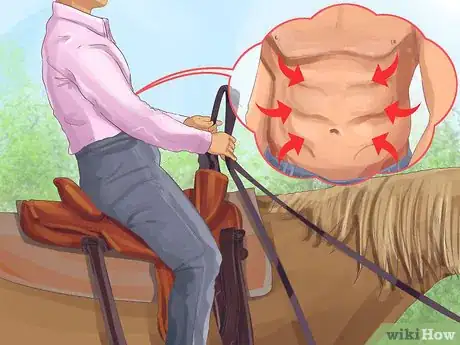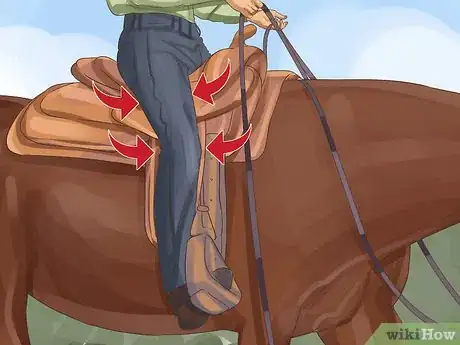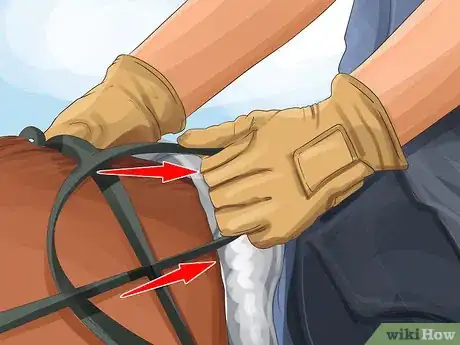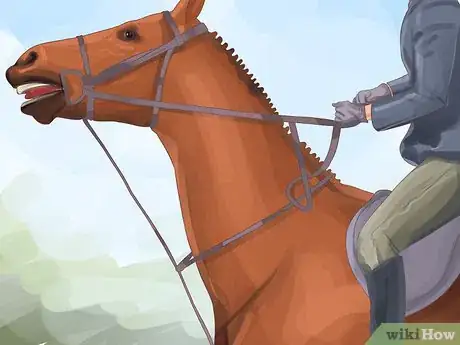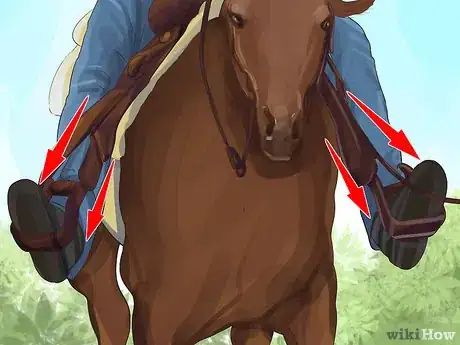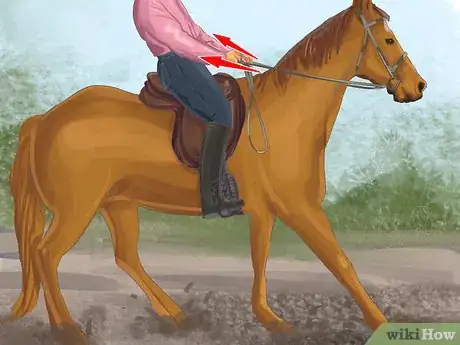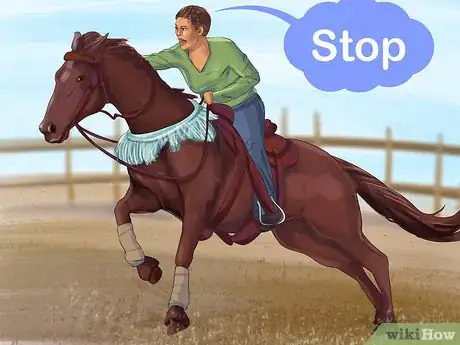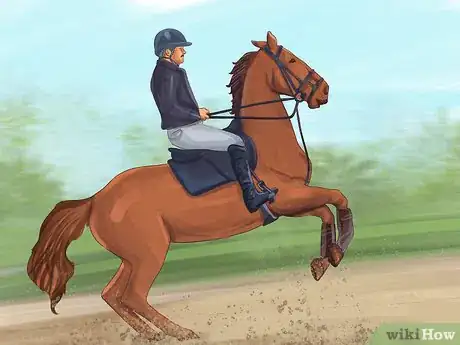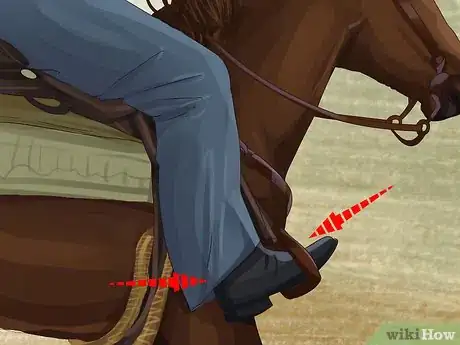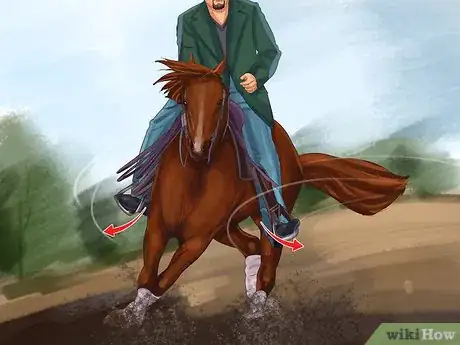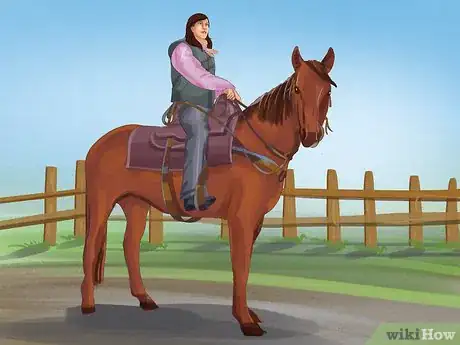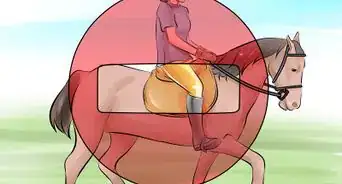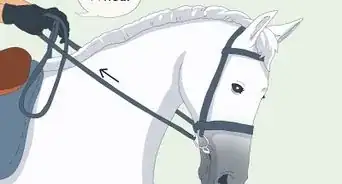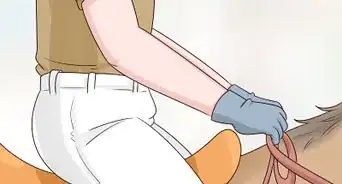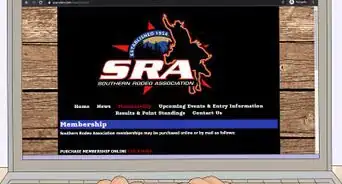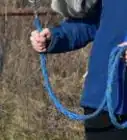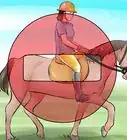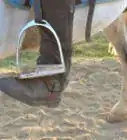This article was co-authored by Ryan Corrigan, LVT, VTS-EVN. Ryan Corrigan is a Licensed Veterinary Technician in California. She received her Bachelor of Science in Veterinary Technology from Purdue University in 2010. She is also a Member of the Academy of Equine Veterinary Nursing Technicians since 2011.
This article has been viewed 103,709 times.
Learning to stop the horse is the first step to becoming a great horseback rider. This will help you establish a bond with your horse, and is a relatively easy technique to learn for beginners. Halting happens in three stages that involve communicating with the horse by using your body, riding equipment, and even voice commands.
Steps
Preparing with a Half-Halt
-
1Resist the horse’s movement by tightening your abdominal muscles. This will cause you to move less smoothly with the horse, and it will begin to sense resistance. Hold the core of your body in a rigid position to slow down the pace slightly.
- Try to avoid tensing your back, as this can cause aches after riding. Focus on engaging the stomach muscles and keeping your tailbone pushed down to fight against the movement of the horse. To help, imagine you are sucking your belly down towards your spine.
-
2Tighten your knees and thighs slightly against the saddle. Tensing your upper legs will signify to the horse that a halt is coming and remind it to prepare for a stop. At this point, your lower legs shouldn’t be squeezing the side of the horse just yet.[1]
- If the horse begins to slow down, adjust your lower legs and release some tension until you are ready to halt completely.
Advertisement -
3Increase your grip on the reins. Tightening your grip will slightly increase the tension on the reins and acts as another cue to the horse that a shift in pace is coming. Hold a little bit tighter, keeping the pressure on both reins even between your two hands.[2]
- Refrain from pulling or tugging on the reins as this can scare the horse and cause it to ignore further signals from your body.
- If your horse becomes scared while adjusting your reins, you will need to calm it as quickly as possible.
-
4Keep the reins in place to stop following the movement of the horse’s head. Steadying the movement from your hands is another way to communicate with the horse that a halt is coming. Hold your hands in one place while gripping the reins to resist against the horse’s movement.[3]
- This will aid the horse in preparing for the next step of the halt without scaring or hurting it.
Completing the Halt
-
1Apply pressure with both legs as you approach the stopping point. About 5 strides from where you would like to stop, gradually begin to squeeze the horse’s sides with both of your legs. Engage your lower legs to send a clearer signal and control the movement of the legs and the barrel of the horse.[4]
- It’s important to apply even pressure with both of your legs to prevent crooked halting.
- Be careful not to kick or frighten the horse, which can distract it from stopping.
-
2Pull the reins toward your body to stop the horse’s movement. Move the reins back about 1 to 2 inches (2.5 to 5.1 cm) while gripping them in your hands to further impede the horse’s ability to move its head. Keep the reins low down near your waist. This will stop the horse’s head bob and encourage the horse to decrease its speed.
- Avoid only using your reins to signal a halt. You should be communicating the halt to the horse with your entire body. Some expert riders are able to halt their horses without pulling on the reins at all.
- Do not pull or yank the reins up towards your chest. This can hurt the horse's mouth.
-
3Say a verbal command for the horse to stop. If your horse knows a command, such as, “Whoa” or “Halt,” give the command as you tighten your legs and pull the reins. Speak in a calm tone that is loud enough so that the horse can hear you.[5]
- If you haven’t taught your horse verbal commands, refrain from using them as they can be confusing. The horse doesn’t naturally know what these words mean, but you can train them to respond to commands over time.
- Refrain from shouting or yelling. The horse’s ears are close to your head, and they will be able to hear you speak even at a regular talking volume.
Adjusting Your Form
-
1Make note of your form after the halt is complete. As you come to a stop, make note of how you’re sitting in the saddle. Your hips should be even, your hands should be holding the reins at an equal distance, your shoulders should be square, and you should be sitting up relatively straight in the saddle.
- If any of these things are off, adjust yourself slightly and then look at the horse’s position to make sure that it has stopped evenly. Make note of what you need to change for next time.
-
2Nudge the horse with your lower legs to adjust its stance. When you look at the horse, you might notice that one of its legs is sticking out slightly. Use your leg on that side to apply pressure to encourage the horse to pull the leg in and stand square.
- If the horse is pretty even, refrain from applying pressure with your legs. This can cause the horse to fidget in expectation of an adjustment next time you halt.
-
3Adjust your leg pressure to the left or right if the horse is crooked. You might notice that the horse is turned to one side or the other when stopped. This happened because you squeezed harder with your leg on that side of the horse during the halt.
- For example, if your horse is facing slightly left, that means that you applied more pressure with the left leg while giving the halt signal.
- Next time you halt, try applying slightly less pressure with that leg.
-
4Return to your normal seated position after the halt. Remaining in the tense upright position for too long can confuse the horse, so return to your normal riding position with loosened reins after a few moments. This will prevent the horse from backing up or becoming annoyed.[6]
- If you’re in the process of training the horse, release the reins as quickly as possible to reward it for stopping. Holding too long can cause it to become nervous because its movements are restrained.
Warnings
- Do not pull, yank, or jerk the reins, or you may hurt your horse's mouth.⧼thumbs_response⧽
- Horseback riding can be dangerous. Always wear a helmet, and do not ride without experienced supervision while learning.⧼thumbs_response⧽
- Some horses, especially racing (or former racing horses), may "run through the bit," which means that pulling on the reins may cause them to go faster. Beginners should not learn on these horses, but use a gentle hand if you encounter this problem.⧼thumbs_response⧽
- Do not stand in your stirrups to pull on the reins.⧼thumbs_response⧽
References
- ↑ http://www.meredithmanor.edu/features/articles/nancy/talking_with_your_seat.asp
- ↑ http://www.meredithmanor.edu/features/articles/nancy/talking_with_your_seat.asp
- ↑ http://www.meredithmanor.edu/features/articles/nancy/talking_with_your_seat.asp
- ↑ https://www.youtube.com/watch?v=7NPg3lcosho
- ↑ https://horseandrider.com/health-and-advice/stop-29834
- ↑ https://www.youtube.com/watch?v=7NPg3lcosho
About This Article
To halt your horse, first slightly tense your legs around the saddle and tighten your grip on the reins. Doing this serves as a cue to your horse that you’re preparing to stop. When you’re about 5 strides from where you want to stop, evenly squeeze your horse’s sides with both legs. While you apply this pressure, pull the reins toward your body, taking care not to yank them up towards your chest since this can hurt your horse. If you keep the reins down by your waist while you pull, then it will make your horse’s head bob and encourage it to slow down. As you’re performing these movements, loudly but calmly say a command like “Whoa" so your horse has a verbal cue to stop. For more help from our Veterinary co-author, including how to adjust your sitting form after your horse has halted, scroll down!
